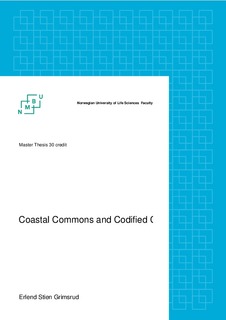| dc.contributor.author | Grimsrud, Erlend Stien | |
| dc.date.accessioned | 2014-08-14T11:32:07Z | |
| dc.date.available | 2014-08-14T11:32:07Z | |
| dc.date.copyright | 2014 | |
| dc.date.issued | 2014-08-14 | |
| dc.identifier.uri | http://hdl.handle.net/11250/217271 | |
| dc.description.abstract | Exploitation of the extensive Norwegian marine resources has entered the era of modern biotechnology- the third strategic technology in the post-war period-with the potential to transform our future, following nuclear- and information technology. Commercial biotechnological application of novel compounds and gene expressions found through marine bioprospecting is at a novel industrial stage, whereas the established aquaculture industry calls for biotechnical solutions to further improve production efficiency and solve biological challenges of increased seafood production. As key components of the national innovation policy for the knowledge based economy, both industries are set in highly complex innovation systems of academia and government. Further complexity should be considered, as the sources of knowledge are genetic resources, considered to be commons or public goods. Traditional innovation literature emphasizes proprietary rights to knowledge as the key driver of high technology innovation. But in the biotechnological sector and when utilizing genetic material, such rights have received much criticism due to aggressive privatisation.
The need for industry-specific knowledge protection strategy regimes has not yet received much attention in Norwegian marine innovation systems. Through the explorative, abductive approach of qualitative research methodology, this study explores several dimensions of intellectual property that can be observed in these systems, and examines their effect on performance of the innovation system. Two separate innovation systems and industries, aquaculture and marine bioprospecting, are examined by survey response analysis and case study interviews to gain perspectives on the implications of knowledge protection. Finally, intellectual property regimes intended to balance proprietary right incentives and the public good concerns are assessed on the basis of respondent insight and literature review. | nb_NO |
| dc.language.iso | eng | nb_NO |
| dc.publisher | Norwegian University of life Sciences, Ås | |
| dc.rights | CC0 1.0 Universal | * |
| dc.rights.uri | http://creativecommons.org/publicdomain/zero/1.0/ | * |
| dc.subject | Intellectual Property | nb_NO |
| dc.subject | Innovation Systems | nb_NO |
| dc.subject | Marine Biotechnology | nb_NO |
| dc.subject | VDP::Samfunnsvitenskap: 200::Rettsvitenskap: 340::Andre rettsvitenskapelige fag: 349 | nb_NO |
| dc.subject | VDP::Samfunnsvitenskap: 200::Økonomi: 210 | nb_NO |
| dc.title | Coastal commons and codified commodities : exploring the role of intellectual property rights on genetic resources in Norwegian marine biotechnological innovation systems | nb_NO |
| dc.type | Master thesis | nb_NO |
| dc.source.pagenumber | 94 | nb_NO |
| dc.description.localcode | M-ØR | nb_NO |

